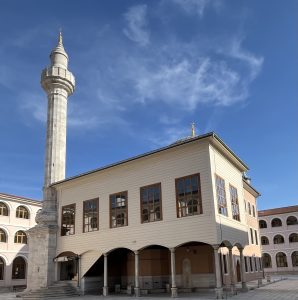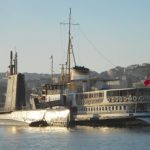“Kasım Paşa”
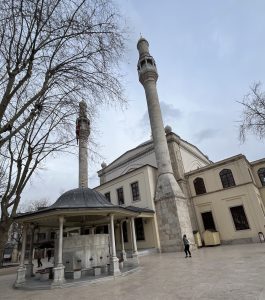
Market: Sunday (Toprak Tabya Sokak, Küçük Piyale)
Named after Kasım Paşa (? – 1543), one of Süleyman the Magnificent’s commanders who was with him at the unsuccessful siege of Vienna in 1529 but who later succeeded in snatching Buda from the Habsburgs for him in 1530, the Golden Horn suburb of Kasımpaşa went on to serve as the site of Constantinople’s most important shipyard right through into the late 19th century. In 2013 it was announced that companies associated with the Rixos Hotel group had won the contract to redevelop the old Tersane-i Amire and Camialtı shipyard sites with hotels, restaurants and shopping facilities. The site is now being extensively reconfigured as part of the Haliçport tourism-encouraging project.
More recently Kasımpaşa has become known as the childhood home of President Recep Tayyıp Erdoğan who grew up apparently near the site of The Palace teahouse which I am yet to track down. Erdoğan’s family hail from the eastern end of the Black Sea around Rize and Kasımpaşa has a strong Black Sea vibe to it.
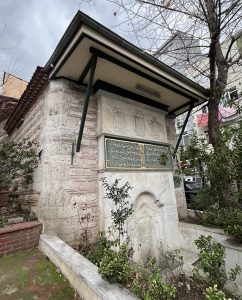 The decline of the shipyards in the 20th century left this a relatively poor part of town; most of the shops are family-run businesses rather than chain stores. However, wander the back streets and amid the usual concrete housing blocks and you’ll stumble on plenty of lovely old fountains (my favourite is the Cezayirli Gazi Hasan Paşa Çesmesi erected in 1780 at the bottom of Paşa Yokuşu and backing onto a sibyan mektebi or primary school) and other reminders of a more elegant past.
The decline of the shipyards in the 20th century left this a relatively poor part of town; most of the shops are family-run businesses rather than chain stores. However, wander the back streets and amid the usual concrete housing blocks and you’ll stumble on plenty of lovely old fountains (my favourite is the Cezayirli Gazi Hasan Paşa Çesmesi erected in 1780 at the bottom of Paşa Yokuşu and backing onto a sibyan mektebi or primary school) and other reminders of a more elegant past.
Around Kasımpaşa
Arriving in Kasımpaşa on the Golden Horn ferry you will step ashore facing the Kalyoncu Kışlası (Barracks of the Galleon Crew), a long, neoclassical structure built round a central courtyard that was commissioned in 1785 by Cezayirli Gazi Hasan Paşa, the Algerian admiral famous for keeping a pet lion, as commemorated by the statue of the pair of them across the road from the barracks (and also in its pair in the Aegean town of Çeşme). It was originally intended to house members of the Ottoman navy and has now been restored to provide the offices for the İstanbul Kaymakamlık. In the courtyard there’s an attractive small mosque with a leaded dome named after the admiral. Inside it features a screened upstairs box where important dignitaries would have been able to pray unobserved.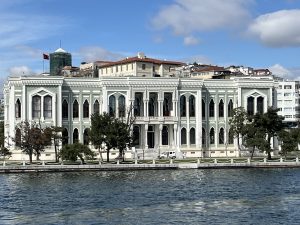
Looking to the left you will see a green palace that has also been completely renovated. It was originally built between 1865 and 1869 by Sarkis Balyan as a home for Abraham Camondo (1781-1873), a Jewish banker who also commissioned the picturesque Camondo Steps in Karaköy‘s Bankalar Caddesi. Later it was used to house the Bahriye Nezreti (Ministry for the Navy). It is not currently open to the public.
High on the hillside above the Bahriye Nezreti and best seen from one of the ferries is the İstanbul Naval Hospital which dates back to 1785 when it was part of a larger hospital complex, now lost.
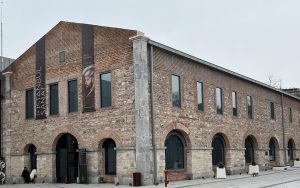 If instead you turn right from the ferry terminal you will come to the Haliç Tersanesi and the İstanbul Sanat Müzesi housed inside what was once a warehouse for the Haliç Shipyard. In 2024 this was still a work in progress although already a first exhibition had showcased beautiful works of art from Turkey’s early and contemporary art scenes. Work is still ongoing to turn this into a much bigger attraction.
If instead you turn right from the ferry terminal you will come to the Haliç Tersanesi and the İstanbul Sanat Müzesi housed inside what was once a warehouse for the Haliç Shipyard. In 2024 this was still a work in progress although already a first exhibition had showcased beautiful works of art from Turkey’s early and contemporary art scenes. Work is still ongoing to turn this into a much bigger attraction.
A little further up the shore of the Golden Horn Sultan Ahmed I commissioned a wooden Tersane Sarayı (Shipyard Palace), of which the only surviving portion is the Aynalıkavak Kasrı (closed Mondays, admission TL130, TL40 for Turks). It was considerably expanded by Sultan Mahmud II who added a throne room and was then renovated by Sultan Abdülmecid in the mid-19th century. The rest of the palace was demolished in 1802-03. The pavilion contains a small museum of musical instruments in memory of Selim III, a cultured sultan who loved music. You can visit the shady magnolia-filled garden for a small fee.
If instead of following the shoreline you head inland along busy Paşakapısı Caddesi you’ll come to the Cami-i Kebir (Güzlce Kasım Paşa Cami), originally a work of Sinan dating back to 1534 but almost completely rebuilt in the 19th century. The restored mosque has a quiet elegance and a fine marble şadırvan and street-facing sebil. Next to it is the Büyük Hamamı. Part of the original Sinan mosque complex, it is the city’s largest bath-house and still in business today with separate chambers for men and women.
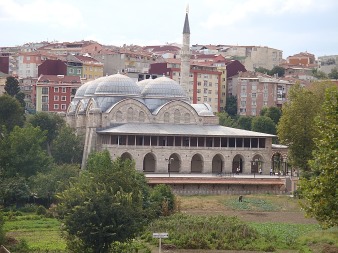 Inland from the Cami-i Kebir but better reached by bus than on foot is another even more impressive mosque, the splendid Piyale Paşa Cami, designed by Sinan in 1573. Despite standing in a fairly desolate part of the city where Kasımpaşa and Dolapdere come together, the mosque is still backed by allotments which gives it an unexpectedly rustic feel. At a quick glance you could be forgiven for thinking that this was a much older mosque than it is since its six equal-sized domes are more reminiscent of Bursa‘s Ulu Cami than İstanbul’s own Süleymaniye with its cascading domes.
Inland from the Cami-i Kebir but better reached by bus than on foot is another even more impressive mosque, the splendid Piyale Paşa Cami, designed by Sinan in 1573. Despite standing in a fairly desolate part of the city where Kasımpaşa and Dolapdere come together, the mosque is still backed by allotments which gives it an unexpectedly rustic feel. At a quick glance you could be forgiven for thinking that this was a much older mosque than it is since its six equal-sized domes are more reminiscent of Bursa‘s Ulu Cami than İstanbul’s own Süleymaniye with its cascading domes.
The mosque comes with a wraparound portico and a single minaret that juts up from the middle of one side. Internally, it reverts more to High Ottoman type with plenty of fine İznik tiles. It’s well worth the effort of seeking it out.
Kasımpaşa Market. Also known as the Kastamonu Market or İnebolu Market because most of its traders travel down from these Black Sea towns to sell their produce, this outdoor Sunday market is well known amongst foodies for the quality and variety of its produce including fine Black Sea bread. The earlier you get here the better; by mid-afternoon the stalls will be closing down. Find the market by heading inland along Bahariye Caddesi (the main road through Kasımpaşa) and then turning left some way past the Cami-i Kebir.
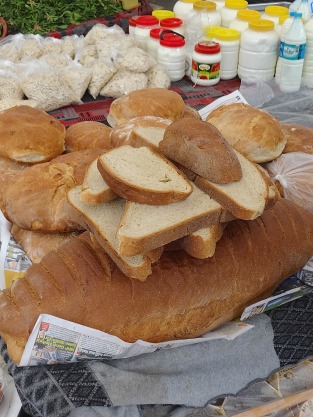 Loaf of bread weighing eight kilos at Kasımpaşa Market
Loaf of bread weighing eight kilos at Kasımpaşa Market
Eating
Kasımpaşa may not be the culinary hub of İstanbul but it’s worth knowing about the Kasımpaşa Sosyal Tesisleri right beside the ferry terminal. Smarter than you’d expect and with a great view of the water, this chain restaurant serves no alcohol which means that bills tend to be low. Its balık çorbası (fish soup) is excellent.
Otherwise the streets around the Cami-i Kebir are filled with inviting small lokantas with the feel of the old Turkey about them.
On a summer’s day few things could be nicer than sitting in the garden cafe at the Aynalıkasrı either.
Transport info
By far the nicest way to reach Kasımpaşa is aboard the Golden Horn ferry from Üsküdar, Kadıköy or Karaköy. However, there are also dolmuşes from the Şişhane exit of the Metro as well as buses from Eminönü and Taksim.
Nearby areas
